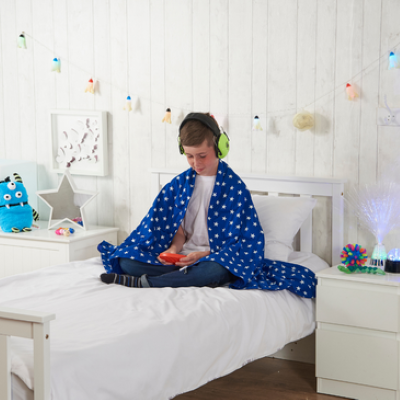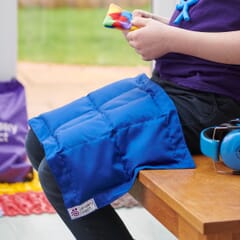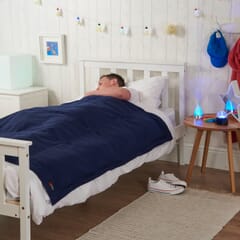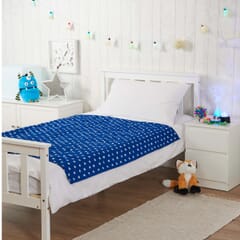Get exclusive deals you won't find anywhere else straight to your inbox.

What Are Weighted Blankets And Lap Pads?
Weighted blankets and lap pads apply a weight and deep pressure that children with sensory integration issues need and positively enjoy.
The weight and pressure helps them to "feel" their body in relation to other things, helping them to slow down and "chill out". This in turn can lead to better concentration, better sleeping and less tantrums!
They are particularly helpful to children and adults with a poor proprioceptive sense who have difficulty interpreting sensations about the position and movement of their body.
Hence they often run, jump, fidget or spin around excessively without getting dizzy. They may also appear clumsy and anxious and bite on clothes or hands to gain some sensory relief.
Children with sensory issues often have difficulty settling down in bed and will regularly wake up in the middle of the night in search of reassurance and often a cuddle.
Sensory Integration
The pioneering American Doctor, Dr. A Jean Ayers in the 1960’s and 70’s, established the concept of Sensory Integration Dysfunction (S.I.D.). We all possess seven senses in total :
- Sight (vision)
- Smell (olfactory sense)
- Taste (gustatory sense)
- Sound (auditory sense)
- Touch (tactile sense)
- Movement (vestibular)
- Body position (proprioception)
We use these seven senses to gather, organise and process information from the environment around us. Our brains process the information and formulate an appropriate response to meet the demands of the environment.
The last 2 senses listed above are perhaps less well known than the other, but no less important in how we react and deal with the world around us.
Movement (vestibular sense)
This sense tells us where our body is in relation to gravity – it gives us our sense of balance and movement telling the brain whether our body is moving and if so how fast. (for example riding bike or on a swing).
Body position (proprioception)
This sense gives us an awareness of our body position in relation to other objects – for example when we are sitting on a chair, messages from the proproiceptors in our legs and back send a message to the brain allowing us to change position on the chair without falling off.
Children with Autism, ADHD, Dyspraxia and other related issues often have Sensory Dysfunction of the Vestibular and Proprioceptive senses.
Some of the signs of dysfunction of the Proprioceptive and Vesitibular sense are:
- Seeking out sensory experiences excessively such as jumping, spinning,
- Rocking and running
- Inability to sit still for any period of time
- Short span of attention
- Excessively clumsy – eg. falling off chairs
- Lack of sense of danger
- Craves bumping and crashing into others
- Chewing on clothing or other things
- Poor sleeping – often getting out of bed in the night
When to use a Weighted Blanket or Lap Pad
Large Weighted Blankets
Generally used at night time to help children (and adults) to stay in bed and get a better nights sleep. The blanket is laid over the child’s normal bedding (duvet or sheets & blanket) and provides deep pressure and a feeling of security.
The cotton mix material means that the blankets do not add much insulation causing the child to become too hot.
Midi Weighted Blanket
Can be used by a smaller child at night or for children and adults during the day (at school or home). When they are getting over excited or distressed the midi blanket can be draped around the shoulders providing pressure to the shoulders and back. Can also be used on the sofa at home whilst watching TV etc.
Lap Pad
Used to place over the knees when the child is sat at their desk at school, at the dinner table or in the car. The lap pad provides weight on the top of the legs and also ensures that the child can feel the back of their legs are pressed against the chair.
Enables the user to sit still for longer periods of time and can help with attention span.






